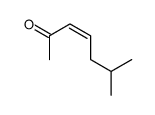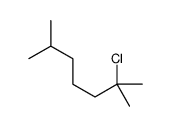13254-34-7
| 中文名 | 2,6-二甲基-2-庚醇 |
|---|---|
| 英文名 | 2,6-Dimethyl-2-heptanol |
| 中文别名 |
2,6-二甲基庚基-2-醇
2,6-二甲基庚醇 大马醇 |
| 英文别名 |
2-Heptanol, 2,6-dimethyl-
MFCD00072198 2,6-Dimethylheptan-2-ol EINECS 236-244-1 2,6-Dimethyl-2-heptanol |
| 密度 | 0.8±0.1 g/cm3 |
|---|---|
| 沸点 | 176.6±8.0 °C at 760 mmHg |
| 熔点 | -10 °C |
| 分子式 | C9H20O |
| 分子量 | 144.255 |
| 闪点 | 70.0±8.2 °C |
| 精确质量 | 144.151413 |
| PSA | 20.23000 |
| LogP | 2.98 |
| 外观性状 | 透明无色液体像酒精的气味 |
| 蒸汽压 | 0.3±0.7 mmHg at 25°C |
| 折射率 | 1.430 |
| 储存条件 | 常温密闭,阴凉通风干燥 |
| 稳定性 | 常温常压下稳定 避免的物料 氧化物 |
| 水溶解性 | SLIGHTLY SOLUBLE |
| 分子结构 | 1、 摩尔折射率:45.2 2、 摩尔体积(cm3/mol):175.0 3、 等张比容(90.2K):399.4 4、 表面张力(dyne/cm):27.1 5、 极化率(10-24cm3):17.92 |
| 计算化学 | 1.疏水参数计算参考值(XlogP):2.7 2.氢键供体数量:1 3.氢键受体数量:1 4.可旋转化学键数量:4 5.互变异构体数量:无 6.拓扑分子极性表面积20.2 7.重原子数量:10 8.表面电荷:0 9.复杂度:84.7 10.同位素原子数量:0 11.确定原子立构中心数量:0 12.不确定原子立构中心数量:0 13.确定化学键立构中心数量:0 14.不确定化学键立构中心数量:0 15.共价键单元数量:1 |
| 更多 | 1. 性状:无色透明液体 2. 密度(g/mL,25℃):0.81 3. 相对密度(20℃,4℃):0.819 4. 熔点(ºC):-10 5. 沸点(ºC,常压):171 6. 相对密度(25℃,4℃):0.815 7. 折射率:1.425-1.427 8. 闪点(ºC):63 9. 常温折射率(n20):1.424 10.常温折射率(n25):1.422 11. 蒸气压(20ºC):未确定 12. 饱和蒸气压(kPa,60ºC):未确定 13. 燃烧热(KJ/mol):未确定 14. 临界温度(ºC):未确定 15. 临界压力(KPa):未确定 16. 油水(辛醇/水)分配系数的对数值:未确定 17. 爆炸上限(%,V/V):未确定 18. 爆炸下限(%,V/V):未确定 19. 溶解性:微溶于水 |
Synonym:Dimetol Section 2 - COMPOSITION, INFORMATION ON INGREDIENTS
Risk Phrases: 36/37/38 Section 3 - HAZARDS IDENTIFICATION EMERGENCY OVERVIEW
Irritating to eyes, respiratory system and skin. Potential Health Effects Eye: Causes eye irritation. May cause chemical conjunctivitis and corneal damage. Skin: Causes skin irritation. May cause cyanosis of the extremities. Ingestion: May cause gastrointestinal irritation with nausea, vomiting and diarrhea. Inhalation: Causes respiratory tract irritation. Aspiration may lead to pulmonary edema. Can produce delayed pulmonary edema. Inhalation at high concentrations may cause CNS depression and asphixiation. Chronic: Effects may be delayed. Section 4 - FIRST AID MEASURES Eyes: Immediately flush eyes with plenty of water for at least 15 minutes, occasionally lifting the upper and lower eyelids. Get medical aid. Skin: Get medical aid. Flush skin with plenty of water for at least 15 minutes while removing contaminated clothing and shoes. Wash clothing before reuse. Ingestion: Never give anything by mouth to an unconscious person. Get medical aid. Do NOT induce vomiting. If conscious and alert, rinse mouth and drink 2-4 cupfuls of milk or water. Inhalation: Remove from exposure and move to fresh air immediately. If not breathing, give artificial respiration. If breathing is difficult, give oxygen. Get medical aid. Do NOT use mouth-to-mouth resuscitation. Notes to Physician: Treat symptomatically and supportively. Section 5 - FIRE FIGHTING MEASURES General Information: As in any fire, wear a self-contained breathing apparatus in pressure-demand, MSHA/NIOSH (approved or equivalent), and full protective gear. During a fire, irritating and highly toxic gases may be generated by thermal decomposition or combustion. Use water spray to keep fire-exposed containers cool. Water may be ineffective. Material is lighter than water and a fire may be spread by the use of water. Combustible liquid. Vapors may be heavier than air. They can spread along the ground and collect in low or confined areas. Containers may explode when heated. Extinguishing Media: In case of fire, use water, dry chemical, chemical foam, or alcohol-resistant foam. Use water spray to cool fire-exposed containers. Water may be ineffective. Section 6 - ACCIDENTAL RELEASE MEASURES General Information: Use proper personal protective equipment as indicated in Section 8. Spills/Leaks: Absorb spill with inert material (e.g. vermiculite, sand or earth), then place in suitable container. Avoid runoff into storm sewers and ditches which lead to waterways. Clean up spills immediately, observing precautions in the Protective Equipment section. Remove all sources of ignition. Use a spark-proof tool. Provide ventilation. Section 7 - HANDLING and STORAGE Handling: Wash thoroughly after handling. Remove contaminated clothing and wash before reuse. Use with adequate ventilation. Avoid contact with eyes, skin, and clothing. Empty containers retain product residue, (liquid and/or vapor), and can be dangerous. Keep container tightly closed. Keep away from heat, sparks and flame. Avoid ingestion and inhalation. Do not pressurize, cut, weld, braze, solder, drill, grind, or expose empty containers to heat, sparks or open flames. Storage: Keep away from heat, sparks, and flame. Keep away from sources of ignition. Store in a tightly closed container. Store in a cool, dry, well-ventilated area away from incompatible substances. Section 8 - EXPOSURE CONTROLS, PERSONAL PROTECTION Engineering Controls: Facilities storing or utilizing this material should be equipped with an eyewash facility and a safety shower. Use adequate ventilation to keep airborne concentrations low. Exposure Limits CAS# 13254-34-7: Personal Protective Equipment Eyes: Wear appropriate protective eyeglasses or chemical safety goggles as described by OSHA's eye and face protection regulations in 29 CFR 1910.133 or European Standard EN166. Skin: Wear appropriate protective gloves to prevent skin exposure. Clothing: Wear appropriate protective clothing to prevent skin exposure. Respirators: A respiratory protection program that meets OSHA's 29 CFR 1910.134 and ANSI Z88.2 requirements or European Standard EN 149 must be followed whenever workplace conditions warrant respirator use. Section 9 - PHYSICAL AND CHEMICAL PROPERTIES Physical State: Liquid Color: clear, colorless Odor: alcohol-like pH: Not available. Vapor Pressure: Not available. Viscosity: Not available. Boiling Point: 180 deg C Freezing/Melting Point: -10 deg C Autoignition Temperature: Not available. Flash Point: 63 deg C ( 145.40 deg F) Explosion Limits, lower: Not available. Explosion Limits, upper: Not available. Decomposition Temperature: Solubility in water: slightly soluble Specific Gravity/Density: .8120g/cm3 Molecular Formula: C9H20O Molecular Weight: 144.26 Section 10 - STABILITY AND REACTIVITY Chemical Stability: Stable at room temperature in closed containers under normal storage and handling conditions. Conditions to Avoid: Incompatible materials, ignition sources, excess heat, strong oxidants. Incompatibilities with Other Materials: Strong oxidizing agents. Hazardous Decomposition Products: Carbon monoxide, irritating and toxic fumes and gases, carbon dioxide. Hazardous Polymerization: Has not been reported Section 11 - TOXICOLOGICAL INFORMATION RTECS#: CAS# 13254-34-7: MJ3324950 LD50/LC50: CAS# 13254-34-7: Draize test, rabbit, eye: 100 mg Severe; Draize test, rabbit, skin: 500 mg Severe; Oral, rat: LD50 = 6800 mg/kg; Skin, rabbit: LD50 = >5 gm/kg. Carcinogenicity: 2-Heptanol, 2,6-dimethyl- - Not listed by ACGIH, IARC, or NTP. Other: See actual entry in RTECS for complete information. Section 12 - ECOLOGICAL INFORMATION Section 13 - DISPOSAL CONSIDERATIONS Dispose of in a manner consistent with federal, state, and local regulations. Section 14 - TRANSPORT INFORMATION IATA Not regulated as a hazardous material. IMO Not regulated as a hazardous material. RID/ADR Not regulated as a hazardous material. Section 15 - REGULATORY INFORMATION European/International Regulations European Labeling in Accordance with EC Directives Hazard Symbols: XI Risk Phrases: R 36/37/38 Irritating to eyes, respiratory system and skin. Safety Phrases: S 24/25 Avoid contact with skin and eyes. S 28A After contact with skin, wash immediately with plenty of water. S 37 Wear suitable gloves. S 45 In case of accident or if you feel unwell, seek medical advice immediately (show the label where possible). WGK (Water Danger/Protection) CAS# 13254-34-7: 1 Canada CAS# 13254-34-7 is listed on Canada's DSL List. CAS# 13254-34-7 is not listed on Canada's Ingredient Disclosure List. US FEDERAL TSCA CAS# 13254-34-7 is listed on the TSCA inventory. SECTION 16 - ADDITIONAL INFORMATION N/A |
|
毒理学数据: 1. 急性毒性:大鼠口服LD50:6800mg/kg;兔子皮肤LD50:>5gm/kg 2. 皮肤眼睛刺激数据:兔子皮肤标准刺激测试:500 mgREACTION SEVERITY :Severe;兔子眼睛标准刺激测试:100 mgREACTION SEVERITY :Severe; 生态学数据: 通常对水体是稍微有害的,不要将未稀释或大量产品接触地下水,水道或污水系统,未经政府许可勿将材料排入周围环境。 CHEMICAL IDENTIFICATION
HEALTH HAZARD DATAACUTE TOXICITY DATA
|
|
~% 
13254-34-7 |
| 文献:Bulletin de la Societe Chimique de France, , vol. <4>43, p. 1108 Comptes Rendus Hebdomadaires des Seances de l'Academie des Sciences, , vol. 177, p. 96 |
|
~% 
13254-34-7 |
| 文献:Journal of the American Chemical Society, , vol. 115, # 1 p. 77 - 81 |
|
~% 
13254-34-7 |
| 文献:Helvetica Chimica Acta, , vol. 50, p. 349 - 354 |
|
~% 
13254-34-7 |
| 文献:Bulletin de la Societe Chimique de France, , vol. <4>39, p. 1438 |
|
~% 
13254-34-7 |
| 文献:Journal of Organic Chemistry, , vol. 51, # 17 p. 3253 - 3256 |
|
~% 
13254-34-7 |
| 文献:Zhurnal Russkago Fiziko-Khimicheskago Obshchestva, , vol. 45, p. 953 Chem. Zentralbl., , vol. 84, # II p. 2129 |
| 海关编码 | 2905199090 |
|---|---|
| 中文概述 | 2905199090. 其他饱和一元醇. 增值税率:17.0%. 退税率:13.0%. 监管条件:无. 最惠国关税:5.5%. 普通关税:30.0% |
| 申报要素 | 品名, 成分含量, 用途, 包装 |
| Summary | 2905199090. saturated monohydric alcohols. VAT:17.0%. Tax rebate rate:13.0%. . MFN tariff:5.5%. General tariff:30.0% |








